Had you taken a random sample of 200 British people 20 years ago, hardly any of them would have heard of charcuterie. Today, the air-dried landscape is very different.
The UK charcuterie scene is one of craft food’s cooler cottage industries and, in an age of overstretched kitchens, the meat board is a popular menu item with caterers. Quick to assemble, impressive when diligently sourced, and suited to the grazing habits of modern restaurant goers, its rise is a win-win for diners and chefs.
If we are going to eat meat post-Cop26, there are worse ways than in a format that encourages the infrequent savouring of small amounts of animal products and, certainly at the top end, careful husbandry of rare-breed animals and nose-to-tail use of every morsel in salamis and patés. Yes, there is terrible faux-artisan charcuterie out there. But you do not have to look far for the good stuff.
Such charcuterie deserves to be thoughtfully served, which is where How to Eat – the series exploring how best to enjoy Britain’s favourite foods – comes in. To avoid meat-board mishaps, coppa catastrophes and sloppy salami, read on.
Cheese
Not the place How to Eat expected to start. But there are many people who seem to believe a charcuterie board should always include cheese. This is wrong. Not because a charcuterie board is, by definition, a collection of cured and cooked meats, but because adding cheese offers too much of a good thing.

While combining red meat and cheese is hardly unusual, it is not automatic. It is an unusually rich agglomeration of protein and fats, which, in their mouth-coating fullness, threaten to cancel one another. In order to take real lingering satisfaction in their resonant flavours, charcuterie and cheese are best enjoyed individually, not in such jumbled chaos. What next? Smoked salmon on the side?
Shopping
Charcuterie is a realm in which, if you do your research, spending a bit more can yield exponential benefits. Conversely, cut costs and (a few bargains notwithstanding) you will often end up with an unedifying collection of arid air-dried hams, spongiform salami and gristly chorizo. Cheap charcuterie is a false economy. Keep it as a rare treat or, for less money, eat something more exciting instead.
The meat mix
A variety of three or four meats differentiated by texture and flavour is optimum. For example, you might serve an air-dried ham or two (if contrasting silky jamón ibérico with drier lomo, for instance); a funky, fermented salami (be it traditionally flavoured with fennel or modern seasonings such as cider, lovage or seaweed); and a chorizo, either curado (eating) chorizo or cooked. You can further increase the combinations by deploying similar items but rendered in unusual meats: lamb, mutton, duck or venison.
But this should not be a free-for-all. For instance, British cooked hams are a limp addition in such boisterously flavoursome company; HTE has yet to meet a bresaola that doesn’t bore it to death; and never-ending, jaw-taxing biltong has no place here. Similarly, ’nduja is a strange inclusion. Its chilli-spiked flavour is a domineering bully and it necessitates the addition of bread or toast. Talking of which …
Soft charcuterie
A phrase that conjures wobbly offal and a whiff of putrefaction, rather than the patés and rillettes intended. Such items should be treated as an optional extra, potentially welcome but inessential. They must offer a genuine point-of-difference on the board rather than a way of cheaply beefing it up.
Bread (sticks)
Unless your meat board includes soft charcuterie, bread has no functional role. Charcuterie is best enjoyed on its own, naked (the charcuterie, not you). You do not ordinarily eat it on or in bread. But, where a board is being eaten as a de facto main course, bread is often added as a bulking agent, eaten at intervals to fill you up. And why not? Good bread and butter is life.
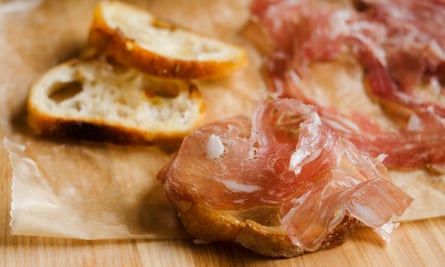
The alternatives, bread sticks or crackers, are poor subs for a good sourdough and take on a Calvinist edge when, all too frequently, they are served without butter. There is an argument a dry cracker is an effective palate cleanser between mouthfuls of meat but, frankly, if you are eating your charcuterie with such steely self-discipline you probably need to relax a bit.
Additions
It is possible to enjoy charcuterie with zero accompaniments. Good cured meats are their own worlds of flavour. You may add items that offer suitable, peripheral entertainment (a complementary note of acidity, a reviving vegetal freshness), but such additions – eaten between mouthfuls of charcuterie, not with – are very much the meat board’s support acts. They should be kept to a judicious minimum.
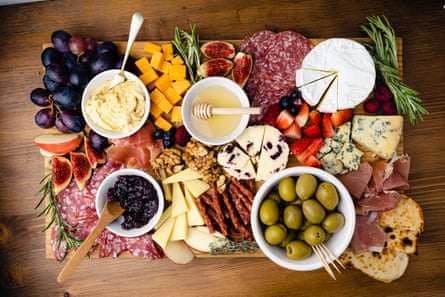
Instead (particularly in the US), the charcuterie board is frequently a crazed extravaganza, a colourful miniaturised buffet of all the foods whose aesthetic abundance is supposed to blind us to the stupidity of serving slices of orange with smoked speck. You cannot simply empty your fridge on to a meat board and hope it works.
For instance, regardless of how many recipes exist for roast figs and Parma ham, HTE is implacably opposed to mixing – in a cavalier, more-is-more lust for all the flavours all the time – sweet and savoury components. It is a potentially catastrophic crossing of the streams that will lead to ugly jarring on the palate. Sweet and savoury items can combine in sublime ways, but, like open-heart surgery, that is an elite activity for highly skilled, dedicated professionals. Not amateurs.
Unwelcome rogue elements
Chutneys, mustards, piccalilli This is not a ploughman’s. You are not eating English ham that needs such boosting.
Honey An abomination in most circumstances, definitely here.
Fresh fruit From the obvious (grapes, apple, figs) to the ridiculous (strawberries, orange, pineapple).
Dried fruit The presence of this reveals a failure of nerve in whoever has composed the board. It is deemed to add glamour but it is less impressive than it first appears. Dried fruit has no raisin (sorry) to be there.
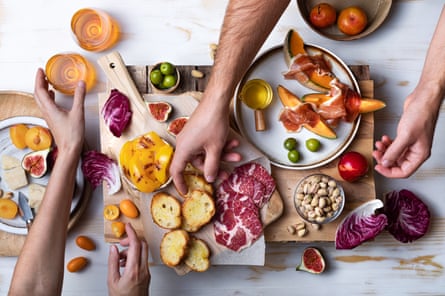
Tomatoes Invariably, in Britain, bullet-hard, unpleasantly astringent cherry tomatoes. You may instead opt for that lairy Hawaiian-shirted loudmouth, the sundried tomato, but HTE would prefer you didn’t.
Green salad You can see the logic. On a board full of meat ribboned with fat, won’t a tangle of watercress and rocket offer a cleansing interregnum of vivid green vitality? No. Against the richness of the meat, it is too wild and mineral an over-correction.
Sliced avocado Increasingly everywhere, unfortunately.
Padron peppers Why are they on there? Because you’ve served bellota and manchego, too? This is not a Spanish theme park, mi amigo.
Justifiable additions
Celeriac remoulade Refreshing, potentially carrying a little heat, but its creaminess dovetails with the fatty meats.
Salted almonds The sodium overlap links the nuts and meat, while offering textural variation and, in the nuts’ earthiness, a certain punctuation.
Fat green olives Either brined or garlic-mined for a pleasant spikiness or in oil for glossy cohesion.
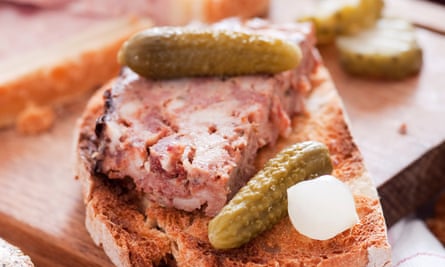
Gherkins, cornichons or, in the same pickled ballpark, silverskin onions
Roasted piquillo peppers For their smoky, brined, charcuterie-adjacent flavours.
Caper berries Like the work of Leigh “Celebrity Juice” Francis, hugely irritating (all those seeds) but kind of magic, too.
Temperature
There is a frigid lifelessness to recently refrigerated charcuterie. It must be served at room temperature, beaded with fat-sweat and ready to yield its secrets.
The board in meat board
Psychologically, there is something dissonant about seeing cured meat served on a cold, hard, clinically white ceramic plate. Instead, a wooden board offers a fitting, attractively rustic platform for fanned, folded, curled and unfurled meat and (thanks to its lower thermal conductivity when touched) an illusory warmth. Plus, the wood yields satisfyingly if you have to cut anything, with less clattering noise than on a plate (a consideration that also rules out slate).
Note: there is no need to buy over-engineered boards with portion partitions, drilled-out hollows or cutlery holders, nor any need to use ramekins to contain olives, nuts etc. It just creates more cleaning and, when sharing, you want as little obstructive clutter on the board as possible. Simply put items that might roll around in the middle of a chopping board, hemmed in with meat and bread. Equipment-wise, keep it simple: fingers, a knife to share, forks and toothpicks per person, are all you need.
Sharing
You know the drill. You cannot hog one meat because you do not like the others. Items must be strictly divided. Any swaps must be fairly negotiated (eg one slice of ham = four pieces of chorizo). Do not leave it until the last mouthful to “try” an item you have previously disregarded, which others around the table love. Finally, if you have Covid reservations about eating at close proximity to others, it is definitely best to choose something else.
So, meat boards, how do you eat yours?
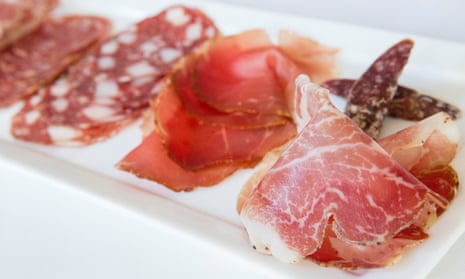
Comments (…)
Sign in or create your Guardian account to join the discussion